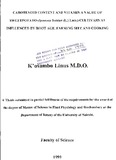| dc.description.abstract | This study involved establishment of the main carotenoids in the storage roots of a
number of sweetpotato (Ipomoea batatas (L.) Lam.) cultivars and determination of the
effect of root age, trial location and cooking on their carotenoid content. Carotenoid
content was evaluated by isocratic non-aqueous reverse phase high performance liquid
chromatography (NARP HPLC) and spectrophotometry. Carotenoids in four selected
cultivars were also analysed with HPLC Photodiode array analyser (HPLC PDA). Vitamin
A value was quantified from the concentration of provitamin A carotenoids and expressed
as retinol equivalent (RE/100g) root fresh weight basis (fwb).
It was revealed that 10 carotenoids were present in the sweetpotato cultivars studied. Of
these, 5 were found to occur in significant quantities. The NARP HPLC elution pattern of
these 5 main carotenoids was consistent among the cultivars studied. Three of these
carotenoids that eluted at 5.36, 8.61 and 14.60 minutes were positively identified using
pure carotenoids to be B-carotene-5,6,5' ,6'-diepoxide,B-carotene-5,6-monoepoxide and
all trans B-carotene, respectively. Only B-carotene and B-catotene-5,6-monoepoxide were
quantified.
Significant variation in carotenoid content among cultivars was evident. Total carotenoid,
B-carotene content and provitamin A varied from 0-8,923 Ilg/100g, 0-7,984 Ilg/100g and
1,258.33 RE/100g (fwb), respectively. The percentage of ~-carotene to total carotenoids
ranged between 0-90% (fwb). Orange fleshed sweetpotatoes contained higher total
carotenoid and B-carotene content and provitamin A value than white to cream fleshed
lines.
The effect of root age on carotenoid content was studied in 5 cultivars: KEMB 10 (CIP
440169), Kakamega 4 (SPK 004) Zapallo (CIP 420027), KSP 20 (TIS 2534) and
Japanese (CIP 420009). Root age was found to exert a significant effect on carotenoid
content. The time taken to attain' maximum carotenoid content was noted to vary with
cultivars. Cultivars, Japanese and Kakamega 4 took 24 weeks while KEMB 10, KSP 20
and Zapallo required up to 24 weeks to achieve peak carotenoid titre.
The effect of farming site on total carotenoid and beta-carotene content was investigated
in KSP 20, LM 88.002 (CIP 188001.2), Japanese and KEMB 10, procured from Kabete,
Kiboko and Kisii. Significant variation in total carotenoid content was observed across
farming sites. However, trial location did not exert a significant effect on ~-carotene
content.
Three boiling regimes were used to assess the effect of cooking. This involved boiling for
30 minutes, 45 minutes and 60 minutes. Boiling caused significant reduction in total
carotenoids and beta-carotene, and had more severe effect on the latter than the former.
HPLC studies showed 'tRat boiling resulted in an increase in the proportion of an
unidentified carotenoid eluting at 3.05" minutes. | en |

